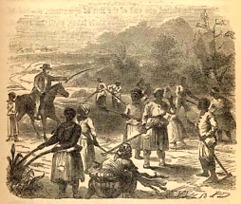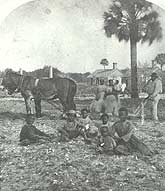I) Behind the Big House – slaves maintained their own society on large plantations, especially on those plantations devoted to growing rice or sugar cane, where they did not have to work constantly under white supervision.
A) Sundown to Sunup – slaves were expected to provided much of their own food, as well as their own care, on their own time—that is, from sundown to sunup. Slaves were also usually required for only a half-day of work on Saturday, as well—although this practice was not universal. Since Sundays were a day of rest, slaves were usually able to have this day off, after attending church services on the plantation, with a plantation owner-approved minister.
1) Diet -- During this time, females often cooked food for dinner, tended the family garden, kept house, etc. Males devoted much of their time to hunting and/or fishing, to supplement the meager amount of meat or fish that the slave owner provided. Slave owners did provide slaves with flour and cornmeal, and a small amount of bacon, salt pork, or some other source of protein.
2) Family life – although the sanctity of African American families was not respected by their white owners, family life in slave families was maintained, because families were important in African American culture (not to mention the fact that raising a family is made easier by having at least two partners joined in the endeavor). It has been argued that the strains placed on black families from this time period have had a detrimental effect upon black families today (Daniel Patrick Moynihan in the early 1960s); that position was disproved by the early 1970s (although the root cause of family problems for many families, poverty, has yet to be addressed adequately).
3) Work life
(a) Gang labor – most slaves on cotton plantations worked in “gangs”—that is, in large groups, in fields, supervised by an overseer, who was usually white. This has been the classic depiction of slavery as it existed in the South, and probably forms our clearest mental picture of how slavery worked.
(b) Task labor – was most prevalent upon rice plantations, as well as sugar cane plantations (outside of harvest time—when they also had to work in gangs harvesting the sugar cane, as well as processing it). Individual slaves were assigned certain jobs to complete during the day, and when those tasks were completed, they were free to pursue other endeavors.
(c) House slaves – the easiest, as well as the hardest, jobs for slaves were often found within the Big House itself. Many house jobs were the least physically demanding, but working in the Big House meant that slaves were in constant contact with their white owners, and often felt their wrath for perceived wrongdoing, or stood accused of stealing something from within the house (which was sometimes the case), or having to stand by mutely while whites in the house talked disparagingly about the shortfall of slaves, in general.
B) Time on the Cross—there is some disagreement among scholars as to how often corporal punishment was used on slaves (namely, whippings and beatings)—and those numbers can be pretty meaningless, anyway. What the evidence does point to is that these severe whippings were used to terrorize the other slaves. This use of terror, alongside the policing system that required whites to participate on slave patrols and the fact that in nearly all Southern states and territories whites outnumbered blacks (with the lone exception of South Carolina), helped to inhibit slave rebellions
1) Nat Turner’s Rebellion—One of the most violent and bloody of the antebellum slave rebellions. Nat Turner and a number of followers entered Turner’s master’s home while the family was sleeping, and murdered the family with axes and hatchets—and then attacked a number of other whites in the area, creating terror in the neighborhood until whites got organized and began a systematic retaliation. The rebellion was put down within 48 hours or so, but Turner eluded capture for 3 weeks. After he was captured, he was tried, convicted, and executed in swift order.
2) The Aftermath of Nat Turner’s Rebellion—although a number of African Americans were tortured and killed during and immediately after the rebellion, this incident did spark a series debate in the state as to whether slavery should continue there or not. As is obvious, Virginia did not abolish slavery in the aftermath of the Turner Rebellion, but the fact that this kind of idea was even discussed at all is significant.
II) Slave life outside the plantation
A) Urban slaves – slaves in southern cities often had uncommon freedom. The often had the ability to hire themselves out to whomever they wished to work for, at a wage they were also free to negotiate—this was the case with Frederick Douglass when he worked as a ship caulker in Baltimore. Slaves in these instances often were permitted to retain a portion of the wage they earned, rather than turning their entire salary over to their master. This was not always the case, however—often slaves had to work for whomever their master directed, at a wage the master negotiated, and never saw any portion of their earnings.
B) Slavery under small slave holders – recall, only 50% of slaves in the South worked on large plantations, and a relatively small number of slaves worked in an urban environment—which means that close to half the slaves employed in the South worked on small farms, often side-by-side with their masters. In many ways, this was the worst of all worlds for slaves, because they were under the constant supervision of their master (often eating and sleeping under the same roof—imagine being with your boss 24-7), performing back-breaking labor, and also working beside your master, so that he does not have the remove of living a life of leisure, but often as not has to be down in the muck the same as the slave—a constant reminder of the common humanity between himself and his slaves.
III) Free Blacks in the South
A) Free Blacks—not all African Americans in the antebellum South were slaves; those African Americans who had been manumitted at an earlier time made up a small, but significant, population in the South
1) Property owners—usually, as a condition for the manumission of slaves, slave holders granted land to the slaves they freed, which then became the property of the freedmen, of course. These freed former slaves could then also acquire more property—even sometimes acquiring slaves themselves
2) Urban workforce—most freed slaves in the South could be found in the urban areas of the South—Charleston, Savannah, and New Orleans. In these urban areas, free blacks competed with whites and slaves for jobs.
IV) Life on the white frontier – the opportunities for whites that the settlement in the Old Southwest created, in turn created new hazards for the African American slaves that southern whites brought with them.
A) Life in the swamps of the Old Southwest – as whites and their African Americans slaves moved into the Old Southwest, particularly the Delta regions of Mississippi and the bayous of Louisiana and eastern Texas, in many ways it was like starting over again in the coastal area of Virginia and the Carolinas—disease was rampant, slaves were worked to death clearing and draining swamps. This meant that slaves were in great demand in the Old Southwest.
B) The market for slaves – the expansion of demand for slaves in the Old Southwest came at a time when the demand for slaves in the Old South was diminishing—which meant that slave traders began to fill those needs by transporting slaves from where they were no longer in great demand to the areas in which they were in demand.
1) Separation of slave families – the sale of slaves to slave traders often meant the break-up of slave families, since traders often had no personal history with the slaves they bought—they were only looking to maximize their investments. Although some slave owners could be swayed by appeals from long time slaves to not separate mothers from their children, often they ignored these pleas to unload their no longer needed slaves. (How does this fact jibe with George Fitzhugh’s portrayal of the “benevolence” of Southern slavery?)
(a) Often slave master’s would agree to sell slaves to neighbor’s, if the slaves themselves could find a local buyer.
(b) Slave families often kept in touch either through the slave grapevine, or by letter (either persuading a master or mistress to write the letter for them, or by composing a letter themselves—despite the perception that all slaves were illiterate, and all of the efforts to keep them that way, some had learned at some point to read and write).
2) The slave pens – as the demand for slaves in the old Southwest grew, places to conveniently purchase slaves grew in importance. The biggest city to buy slaves was at New Orleans, which had numerous slaves “pens” where purchasers gathered to look over potential purchases, like one would for cattle or other livestock.










No comments:
Post a Comment